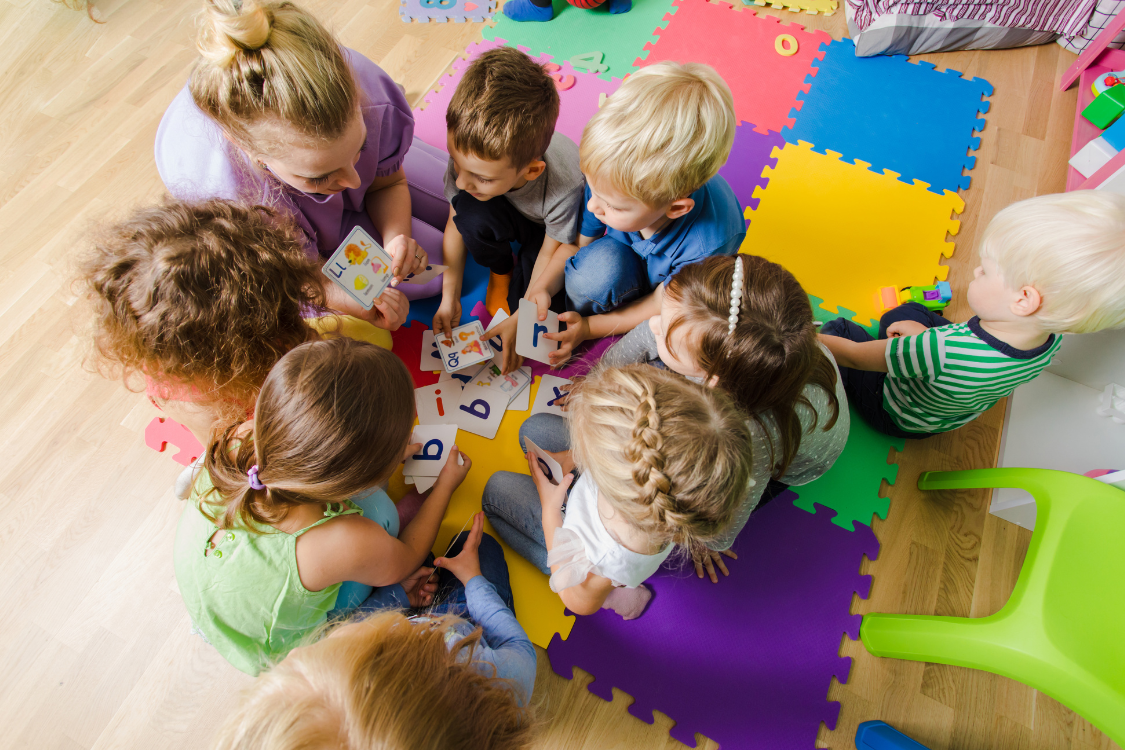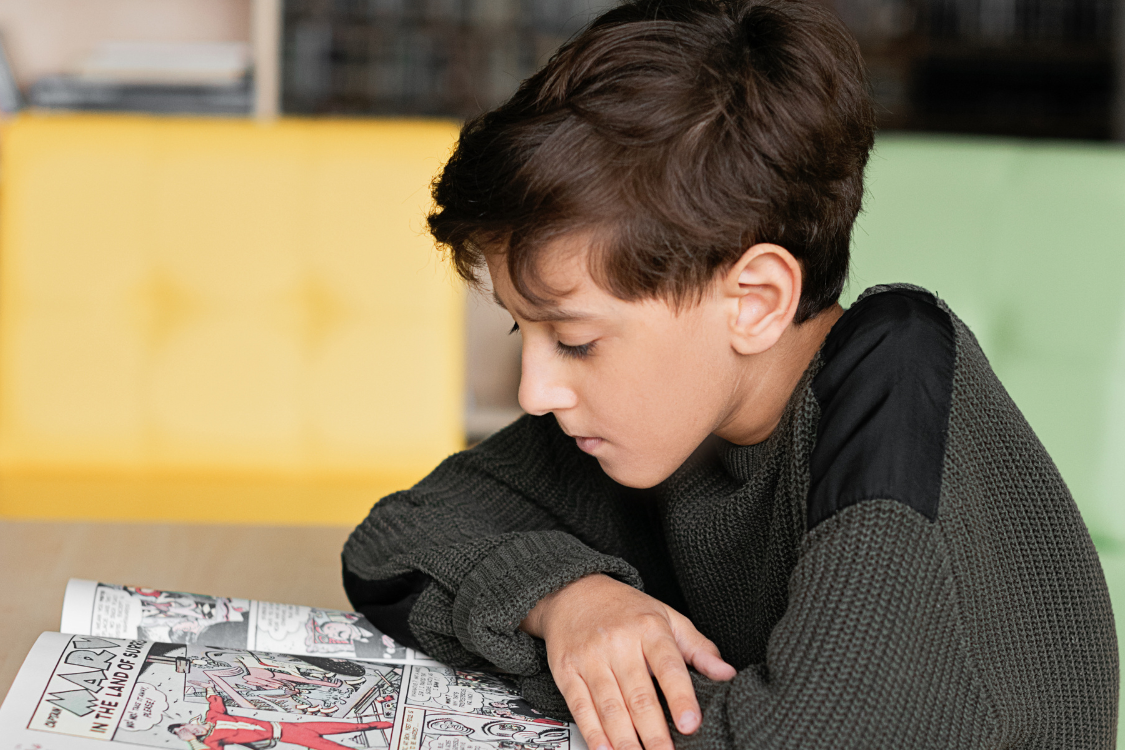Picture this: Your child’s eyes light up as they successfully sound out a word in their favorite storybook. That magical “I did it!” moment happens not because they memorized flashcards, but because they’re applying phonics skills in a meaningful context they actually enjoy.
While worksheets and drills have their place in learning to read, nothing brings phonics to life quite like well-chosen children’s literature. When children encounter letter patterns in engaging stories rather than isolated exercises, they make stronger neural connections that help them retain what they’ve learned. A study published in the Journal of Educational Psychology found that contextual learning improved phonics retention by up to 40% compared to drill-based approaches alone (National Reading Panel, 2023).
This comprehensive guide organizes over 200 children’s books by specific phonics skills—from basic letter recognition to advanced vowel patterns and everything in between. Whether your child is just beginning to connect letters and sounds or is ready to tackle complex spelling patterns, you’ll find precisely the right books to support their reading journey.
What makes this approach so effective? When children see phonics patterns in books they enjoy, they understand that these “rules” aren’t just arbitrary exercises—they’re tools that unlock the stories they love. This connection transforms phonics from something they have to learn into something they want to master.
As reading specialist Dr. Marilyn Adams notes, “Children need to see that phonics is not an end in itself, but a means to the magnificent world of reading.” The books in this collection serve as bridges between skill-building and the joy of reading, helping children develop both competence and confidence on their literacy journey.
Ready to find the perfect books to support your young reader? Let’s explore the wonderful world of phonics through literature!
How to Use Books in Your Phonics Teaching Routine
The “Read, Identify, Practice” Method for Maximum Learning
Creating a structured routine with phonics-focused books helps children connect abstract letter-sound concepts with meaningful reading experiences. The most effective approach follows a simple three-step process that research has shown maximizes both skill development and reading enjoyment.
Step 1: Explicitly teach the target phonics skill before opening the book. For example, if you’re focusing on the short ‘a’ sound, practice the sound in isolation, then in sample words. Show your child how to position their mouth, and provide clear examples of the sound in familiar words like “cat,” “map,” and “hat.”
Step 2: Introduce a book that features the target pattern, explaining that you’ll be looking for words with that sound as you read. As you encounter words with the target pattern, briefly pause to highlight them. “Look! I see the short ‘a’ sound in ‘map’ just like we practiced!” This explicit connection helps children see phonics patterns in action.
Step 3: After reading, engage in a simple activity that reinforces the pattern. You might create a list of short ‘a’ words from the story, play a quick word-building game with magnetic letters using the pattern, or challenge your child to find objects around the house that contain the target sound.
According to the Florida Center for Reading Research, this structured yet playful approach helps children develop both phonics skills and comprehension simultaneously, creating a powerful foundation for reading success (FCRR, 2024).
Companion Books Strategy: Doubling Your Impact
One particularly effective approach is using “companion books” that complement your phonics instruction in two different ways:
Sound-Focused Books: These books feature multiple examples of your target phonics pattern, providing repeated exposure to the sound-spelling relationship. For instance, when teaching the ‘sh’ digraph, “Sheep on a Ship” by Nancy Shaw offers numerous opportunities to practice this sound in an engaging story context.
Subject-Focused Books: These books align with the theme or subject of your phonics lesson, making learning more cohesive and engaging. If your phonics poem or lesson is about owls, pairing it with a thematically related book about owls can deepen understanding while maintaining interest.
Dr. Timothy Shanahan, former director of reading for the Chicago Public Schools, emphasizes that this dual approach helps children see patterns across different texts, strengthening their ability to transfer phonics skills to new reading situations (International Literacy Association, 2023).
Remember that the goal isn’t just to develop technical reading skills but to nurture a love of reading that will serve your child throughout life. By thoughtfully selecting books that reinforce specific phonics patterns while capturing your child’s imagination, you create powerful learning opportunities disguised as enjoyable reading time.
For children who need extra support, don’t rush through books. Revisit favorites multiple times, each time focusing on a different skill or pattern. This repeated exposure builds confidence and fluency while deepening understanding of how phonics works in real reading contexts.
Beginning Phonics Skills Books
Let’s go through the books that should be on your shelf (or library list!) from day one.
Important Note for Parents: These books are intended to be read aloud by adults to children who are learning beginning phonics skills. While your child won’t be able to read these independently yet, hearing you read them while pointing out letter patterns helps build essential pre-reading connections. The engaging stories and illustrations will keep children interested while you highlight specific phonics elements in a natural, enjoyable way.
Letter Recognition Books: Building the Alphabet Foundation
Before children can decode words, they need a solid foundation in letter recognition—identifying both the shapes and names of letters. These engaging books make learning the alphabet a joyful experience rather than a tedious chore.
Alphabet Adventures:
- “Chicka Chicka Boom Boom” by Bill Martin Jr. and John Archambault – Letters race to climb a coconut tree in this rhythmic classic.
- “LMNO Peas” by Keith Baker – Tiny pea characters demonstrate activities for each letter of the alphabet.
- “A Is for Apple” by Georgie Birkett – Tactile, interactive board book with raised letters children can trace.
- “Z Is for Moose” by Kelly Bingham – A humorous take on an alphabet book with an impatient moose.
- “AlphaOops!: The Day Z Went First” by Alethea Kontis – An alphabet book in reverse with charming chaos.
- “Eating the Alphabet: Fruits & Vegetables from A to Z” by Lois Ehlert – Vibrant illustrations of produce organized alphabetically.
- “The Turn-Around, Upside-Down Alphabet Book” by Lisa Campbell Ernst – Letters transform into objects when turned different directions.
- “Dr. Seuss’s ABC” by Dr. Seuss – Whimsical alliterative phrases for each letter.
- “A to Z” by Sandra Boynton – Simple, humorous letter book perfect for very young children.
- “Alphabet Under Construction” by Denise Fleming – Mouse works on constructing each letter through different activities.
Letter-Sound Connection Books:
- “The Alphabet Tree” by Leo Lionni – Letters learn to form words and sentences in this gentle story.
- “Alphabet Rescue” by Audrey Wood – Lowercase letters save the day in this adventure.
- “I Spy Letters” by Jean Marzollo – Hidden letter search combining visual discrimination with letter recognition.
- “A Is for Angry: An Animal and Adjective Alphabet” by Sandra Boynton – Introduces adjectives while reinforcing letter sounds.
- “Alpha Oops!: H Is for Halloween” by Alethea Kontis – Halloween-themed alphabet book with rich vocabulary.
The key to effective letter recognition instruction is making it multisensory and meaningful. As you read these books, invite children to trace letters with their fingers, find letters in the environment, and connect letters to their own names and experiences.
Phonological Awareness Books: Playing with Sounds
Phonological awareness—the ability to recognize and manipulate the sounds of spoken language—is a critical precursor to phonics success. These books help children develop an ear for language through rhyme, rhythm, and sound play.
Rhyming Books:
- “Llama Llama Red Pajama” by Anna Dewdney – Simple rhyming patterns in a soothing bedtime story.
- “Each Peach Pear Plum” by Janet and Allan Ahlberg – Classic rhyming book with seek-and-find elements.
- “Sheep in a Jeep” by Nancy Shaw – Short, humorous rhyming text about sheep’s misadventures.
- “Giraffes Can’t Dance” by Giles Andreae – Encouraging story with accessible rhymes.
- “Rhyming Dust Bunnies” by Jan Thomas – Hilarious book where dust bunnies play rhyming games.
- “The Gruffalo” by Julia Donaldson – Rich vocabulary in rhyming patterns within an engaging forest adventure.
- “Frog on a Log?” by Kes Gray – Explores rhyming word families through animal seating arrangements.
- “Room on the Broom” by Julia Donaldson – Rhythmic Halloween story perfect for reinforcing rhyming patterns.
- “Bear Snores On” by Karma Wilson – Gentle rhyming story about woodland animals and a sleeping bear.
- “Hairy Maclary from Donaldson’s Dairy” by Lynley Dodd – Adventure featuring dogs with rhyming descriptions.
Alliteration Books:
- “Some Smug Slug” by Pamela Duncan Edwards – Alliterative adventure featuring the letter S.
- “Busy Buzzing Bumblebees” by Dawn Bentley – Rhythmic text highlighting the B sound.
- “Six Sick Sheep” by Judith Ross Enderle and Stephanie Gordon Tessler – Tongue-twisting alliterative story.
- “Peter Piper’s Practical Principles of Plain and Perfect Pronunciation” by Susan Pearson – Playful approach to alliteration.
- “Faint Frogs Feeling Feverish” by Leslie Kimmelman – Alliterative text with F sounds in a humorous context.
Sound Awareness Books:
- “Click, Clack, Moo: Cows That Type” by Doreen Cronin – Emphasizes sound words through onomatopoeia.
- “We’re Going on a Bear Hunt” by Michael Rosen – Repeated sound patterns create rhythm and awareness.
- “Tanka Tanka Skunk!” by Steve Webb – Introduces syllable counting through animal names and drum beats.
- “Moo, Baa, La La La!” by Sandra Boynton – Simple animal sounds for sound discrimination.
- “Trashy Town” by Andrea Zimmerman and David Clemesha – Repetitive refrains with varied ending sounds.
Fun fact! Children who engage regularly with rhyming and sound play books develop stronger phonological awareness, which translates to greater success when formal phonics instruction begins.
Core Phonics Skills Books
Now it’s time to think through the books you’ll want to have on hand to reinforce all of the core phonics skills your early reader is learning.
Short Vowel Sounds: The Building Blocks of Reading
Short vowel sounds are typically among the first phonics skills taught explicitly. These carefully selected books provide authentic exposure to each short vowel sound in engaging contexts.
Reading Strategy Note: When using these books with your developing reader, focus specifically on having them read just the words containing the target phonics pattern they’re currently learning. For example, with a short ‘a’ book, you might read most of the text but pause and let your child decode words like “cat,” “hat,” or “map.” This targeted approach builds confidence while preventing frustration that could come from expecting them to read the entire book independently. As their skills grow, they can gradually take on more words in each reading session.
Short A Books:
- “Pat the Cat” by Colin and Jacqui Hawkins – Simple text focused almost exclusively on short A words.
- “I Want My Hat Back” by Jon Klassen – Award-winning story with numerous short A opportunities.
- “Caps for Sale” by Esphyr Slobodkina – Classic tale with many short A words throughout.
- “Hi, Cat!” by Ezra Jack Keats – Neighborhood adventure with natural short A vocabulary.
- “Bad Cat” by Nicola O’Byrne – Humorous story with focused short A vocabulary.
- “The Cat in the Hat” by Dr. Seuss – While known for rhyme, this classic also contains many short A words.
- “That’s (Not) Mine” by Anna Kang – Simple story about sharing with natural short A word usage.
- “The Bad Seed” by Jory John – Character-driven story featuring many short A words.
- “Sam and Dave Dig a Hole” by Mac Barnett – Adventure story with natural short A vocabulary.
- “Max the Brave” by Ed Vere – Short, humorous story about a brave kitten with many short A words.
Short E Books:
- “Get Well, Mercer Mayer!” by Mercer Mayer – Story about getting sick and feeling better with many short E words.
- “Henny, Penny, Lenny, Denny, and Mike” by Cynthia Rylant – Fish friends story rich in short E sounds.
- “Ed and Ted” by Kevin Luthardt – Simple friendship story focusing on short E words.
- “Ten Red Hens” by Anita Lobel – Counting book with many opportunities to identify short E sounds.
- “Don’t Let the Pigeon Drive the Bus!” by Mo Willems – Humorous story with natural short E vocabulary.
- “The Very Hungry Caterpillar” by Eric Carle – Classic with several short E words in context.
- “Red Sled” by Lita Judge – Nearly wordless book where adding short E words enhances the story.
- “Wet Pet” by Dr. Seuss – Early reader with controlled short E vocabulary.
- “Elephant and Piggie: Let’s Go for a Drive!” by Mo Willems – Conversation-based story with many short E opportunities.
- “The Best Nest” by P.D. Eastman – Bird adventure with numerous short E words.
Short I Books:
- “Pig the Pug” by Aaron Blabey – Humorous story about a selfish pug with natural short I words.
- “Big Pig on a Dig” by Phil Roxbee Cox – Silly adventure focusing on short I words.
- “Fix It” by David McPhail – Simple story about fixing toys with short I vocabulary.
- “I’m a Big Brother/I’m a Big Sister” by Joanna Cole – Family stories with natural short I usage.
- “Llama Llama Misses Mama” by Anna Dewdney – School separation story with many short I opportunities.
- “Little Critter: Just a Little Sick” by Mercer Mayer – Story about being sick with natural short I words.
- “Armadilly Chili” by Helen Ketteman – Southwestern tale full of short I words.
- “Fish Wish” by Bob Barner – Underwater adventure with focused short I vocabulary.
- “Six Sticks” by Molly Coxe – Early reader with controlled short I vocabulary.
- “This Is the Kiss” by Claire Harcup – Bedtime story with natural short I words.
The Ultimate Master List of Phonics Books: Organized by Reading Skills
Short O Books:
- “Fox in Socks” by Dr. Seuss – Tongue-twisting story with numerous short O words.
- “Hop on Pop” by Dr. Seuss – Simple rhyming text with many short O opportunities.
- “Hot Rod Hamster” by Cynthia Lord – Racing adventure with natural short O vocabulary.
- “The Big Orange Splot” by Daniel Manus Pinkwater – Neighborhood tale with many short O words.
- “Rocks in My Pockets” by Marc Harshman – Mountain adventure incorporating short O sounds.
- “Not a Box” by Antoinette Portis – Imaginative story about creative play with natural short O words.
- “Bob Books: Set 1, Book 1” by Bobby Lynn Maslen – Beginning reader focused on short O words.
- “Spots, Feathers, and Curly Tails” by Nancy Tafuri – Farm animal identification with short O vocabulary.
- “Fox on the Job” by James Marshall – Humorous story with many short O opportunities.
- “Hog on a Log” by Phil Roxbee Cox – Simple story focused specifically on short O words.
Short U Books:
- “Duck on a Bike” by David Shannon – Humorous farm story with many short U words.
- “Chuck and Woodchuck” by Cece Bell – Friendship story with natural short U vocabulary.
- “Good Luck, Duck” by Meindert DeJong – Adventure with focused short U vocabulary.
- “Tub Toys” by Terry Miller Shannon – Bath time fun with numerous short U words.
- “Just a Bug” by Gina and Mercer Mayer – Simple story with natural short U usage.
- “Mush, a Dog from Space” by Daniel Pinkwater – Silly story with many short U words.
- “Buzz, Buzz, Buzz” by Byron Barton – Simple bee story with short U focus.
- “Jump, Frog, Jump!” by Robert Kalan – Cumulative tale with regular short U words.
- “Duck in the Truck” by Jez Alborough – Rhyming story with short U focus.
- “Stuck” by Oliver Jeffers – Humorous problem-solving story with many short U words.
Consonant Sounds: Building Block Basics
Mastering consonant sounds provides the framework for decoding. These books highlight specific consonant sounds in engaging contexts.
Beginning Consonants Books:
- “Kipper’s Toybox” by Mick Inkpen – Story about a dog’s lost toys featuring numerous beginning consonants.
- “Brown Bear, Brown Bear, What Do You See?” by Bill Martin Jr. – Repetitive text highlighting various beginning consonants.
- “Big Dog, Little Dog” by P.D. Eastman – Opposites book featuring many beginning consonant sounds.
- “My “b” Sound Box” by Jane Belk Moncure (and entire alphabet series) – Focused books for specific beginning consonants.
- “Ten Black Dots” by Donald Crews – Counting book with varied beginning consonants.
Ending Consonants Books:
- “Cat Traps” by Molly Coxe – Simple story highlighting words ending in various consonants.
- “Top Cat” by Lois Ehlert – Colorful story with many CVC words showing ending consonants.
- “Ten, Nine, Eight” by Molly Bang – Countdown book with various ending consonant words.
- “Biscuit’s Day at the Farm” by Alyssa Satin Capucilli – Simple adventure with naturally occurring ending consonants.
- “Pat the Bunny” by Dorothy Kunhardt – Classic tactile book with simple words showcasing ending consonants.
Hard and Soft Consonant Sounds Books:
- “The Giant Jam Sandwich” by John Vernon Lord – Village story with examples of both hard and soft C and G.
- “George and Martha” by James Marshall – Friendship stories with numerous examples of soft G.
- “If You Give a Mouse a Cookie” by Laura Numeroff – Classic cause-and-effect story with various C sounds.
- “Cinderella” (various versions) – Traditional tale with many examples of soft C.
- “The Gingerbread Man” (various versions) – Classic tale featuring both hard and soft G sounds.
The International Literacy Association’s research on early reading development highlights the importance of explicit consonant instruction paired with authentic literature. Children benefit from seeing the same letter patterns in multiple contexts, which these carefully selected books provide (International Literacy Association, 2024).
Consonant Blends and Digraphs: Combining Sounds
As children progress in their phonics journey, they encounter more complex letter patterns. These books make learning consonant blends and digraphs more accessible and enjoyable.
L-Blends Books (bl, cl, fl, gl, pl, sl):
- “Click, Clack, Moo: Cows That Type” by Doreen Cronin – Farm story featuring CL blend throughout.
- “Blueberries for Sal” by Robert McCloskey – Classic bear story with many BL blend words.
- “Fletcher and the Falling Leaves” by Julia Rawlinson – Seasonal story highlighting FL blend.
- “Plantzilla” by Jerdine Nolen – Humorous story featuring PL blend words.
- “The Very Clumsy Click Beetle” by Eric Carle – Persistence story with natural CL blend usage.
- “Sleep Like a Tiger” by Mary Logue – Bedtime story featuring SL blend words.
- “Glad Monster, Sad Monster” by Ed Emberley – Emotions book with GL blend focus.
- “Sloth Slept On” by Frann Preston-Gannon – Adventure featuring SL blend words.
- “Blossom Possum” by Gina Newton – Australian animal tale with BL blend words.
- “Cloudy With a Chance of Meatballs” by Judi Barrett – Imaginative story with CL blend focus.
R-Blends Books (br, cr, dr, fr, gr, pr, tr):
- “Brave Bear” by Sean Taylor – Courage-themed story featuring BR blend words.
- “Truck” by Donald Crews – Simple vehicle book highlighting TR blend.
- “Grumpy Bird” by Jeremy Tankard – Mood-themed story with GR blend focus.
- “The Gingerbread Baby” by Jan Brett – Adventure featuring many R-blend words.
- “Dragons Love Tacos” by Adam Rubin – Humorous story with DR blend words.
- “The Gruffalo” by Julia Donaldson – Forest adventure with many GR words.
- “A Friend for Dragon” by Dav Pilkey – Friendship story highlighting DR blend.
- “The Tractor in the Haystack” by Craig Brown – Farm story with TR blend focus.
- “From Head to Toe” by Eric Carle – Movement story with natural R-blend usage.
- “Frederick” by Leo Lionni – Mouse story with FR blend focus.
S-Blends Books (sc, sk, sl, sm, sn, sp, st, sw):
- “Snowy Day” by Ezra Jack Keats – Classic winter adventure featuring SN blend.
- “Stop Snoring, Bernard!” by Zachariah O’Hora – Humorous story with ST and SN blends.
- “Skateboard Scramble” by Doug Cushman – Sports story highlighting SK blend.
- “Stellaluna” by Janell Cannon – Bat adventure with many ST blend words.
- “Swimmy” by Leo Lionni – Ocean adventure featuring SW blend.
- “Small in the City” by Sydney Smith – Urban tale with SM blend focus.
- “The Snail and the Whale” by Julia Donaldson – Journey story highlighting SN blend.
- “Sparky!” by Jenny Offill – Pet story featuring SP blend words.
- “Scaredy Squirrel” by Melanie Watt – Humorous character story with SC blend focus.
- “Sleep, Big Bear, Sleep!” by Maureen Wright – Hibernation story with SL blend words.
SH-Digraph Books:
- “Sheep in a Jeep” by Nancy Shaw – Humorous adventure packed with SH words.
- “Shark in the Park” by Nick Sharratt – Rhyming adventure with SH focus.
- “Too Shy for Show and Tell” by Beth Bracken – School story featuring many SH words.
- “Sheep on a Ship” by Nancy Shaw – Alliterative adventure highlighting SH digraph.
- “Shoe-la-la!” by Karen Beaumont – Shopping adventure with SH focus.
Did you know…. Children who regularly engage with books featuring specific consonant patterns have a better ability to decode unfamiliar words containing those patterns compared to control groups (Journal of Literacy Research, 2024). This reinforces the importance of intentionally selecting books that feature target phonics patterns.
CH-Digraph Books:
- “Chugga-Chugga Choo-Choo” by Kevin Lewis – Train adventure highlighting CH sounds.
- “Inch by Inch” by Leo Lionni – Measuring inchworm story with natural CH words.
- “Much Bigger Than Martin” by Steven Kellogg – Sibling story featuring CH digraph.
- “Lunch” by Denise Fleming – Simple food story with CH focus.
- “Cha-Cha Chimps” by Julia Durango – Dancing primates with abundant CH words.
- “The Chicken-Chasing Queen of Lamar County” by Janice N. Harrington – Farm adventure with CH focus.
- “The Children’s Garden” by Carole Lexa Schaefer – Community garden story with many CH words.
- “Which Would You Rather Be?” by William Steig – Choice-based story highlighting CH digraph.
- “Chester’s Way” by Kevin Henkes – Friendship story with CH-named main character.
- “Itchy, Itchy Chicken Pox” by Grace MacCarone – Illness story with numerous CH words.
TH-Digraph Books:
- “There Was an Old Lady Who Swallowed a Fly” by Simms Taback – Cumulative tale with TH focus.
- “Things I Like” by Anthony Browne – Simple preferences book featuring TH words.
- “Thank You, Bear” by Greg Foley – Friendship story with TH focus.
- “How Many Teeth?” by Paul Showers – Informative book with natural TH usage.
- “The Three Billy Goats Gruff” (various versions) – Classic tale featuring TH prominently.
- “The Things I Love About Pets” by Trace Moroney – Pet appreciation with TH focus.
- “Thump, Quack, Moo” by Doreen Cronin – Farm adventure with TH digraph.
- “This Moose Belongs to Me” by Oliver Jeffers – Ownership story with THIS usage.
- “That Rabbit Belongs to Emily Brown” by Cressida Cowell – Toy adventure featuring THAT.
- “Something Beautiful” by Sharon Dennis Wyeth – Community story with natural TH usage.
WH-Digraph Books:
- “Where’s Spot?” by Eric Hill – Classic lift-the-flap book focusing on WHERE.
- “Where the Wild Things Are” by Maurice Sendak – Adventure beginning with WH question.
- “What Do You Do With an Idea?” by Kobi Yamada – Inspirational story with WHAT focus.
- “When Spring Comes” by Kevin Henkes – Seasonal book highlighting WHEN.
- “Who Sank the Boat?” by Pamela Allen – Mystery story focusing on WHO.
- “What Do You Do With a Problem?” by Kobi Yamada – Companion to “Idea” with WH focus.
- “When a Dragon Moves In” by Jodi Moore – Imaginative beach story with WHEN focus.
- “What Will Hatch?” by Jennifer Ward – Science prediction book with WH emphasis.
- “Wheels on the Bus” (various versions) – Song book featuring WHEELS.
- “Whistle for Willie” by Ezra Jack Keats – Skill development story with WH digraph.
PH-Digraph Books:
- “The Alphabet Tree” by Leo Lionni – Letter story featuring alphabet concepts.
- “Elephant and Piggie” series by Mo Willems – Friendship stories featuring an elephant.
- “Alpha Oops!” by Alethea Kontis – Alphabet adventure with PH words.
- “The Photo Book” by Lori Ries – Simple story focused on photography.
- “Phoebe and Digger” by Tricia Springstubb – New sibling story with PH character name.
- “Elephant’s Story” by Tracey Campbell Pearson – Adventure with elephant protagonist.
- “What Elephant?” by Geneviève Côté – Friendship story with elephant character.
- “Dolphin Talk” by Wendy Pfeffer – Informational book about dolphins.
- “Phantoms of the Forest” by Diane Swanson – Nature book featuring PH words.
- “Sophie the Giraffe” by DK – Board book with Sophie the giraffe toy.
Intermediate Phonics Skills Books
Time to level up? Let’s talk about books that reinforce specific phonics skills, letter sounds, etc.
Long Vowel Patterns: The Magic E and Vowel Teams
As children advance in their phonics journey, they encounter long vowel patterns. These books help them master these important spelling patterns through engaging stories.
Long A with Silent E Books:
- “Jane and the Dragon” by Martin Baynton – Medieval adventure with many A-E words.
- “Brave Girl” by Michelle Markel – Historical story with BRAVE in the title.
- “Kate and the Beanstalk” by Mary Pope Osborne – Fairy tale adaptation with A-E names.
- “A Cake for Chase” by Sarah Weeks – Cooking adventure focused on A-E words.
- “Make Way for Ducklings” by Robert McCloskey – Classic with many A-E words.
- “The Great Race” by David Bouchard – Competition story with natural A-E usage.
- “The Tale of Peter Rabbit” by Beatrix Potter – Garden adventure with many A-E words.
- “Same, Same But Different” by Jenny Sue Kostecki-Shaw – Friendship story with SAME focus.
- “Jake Bakes Cakes” by Gerald Hawksley – Cooking story focused on A-E pattern.
- “The Magic Cape” by Laura Sauer – Superhero story with A-E in title.
Long E with Silent E Books:
- “Pete the Cat: I Love My White Shoes” by Eric Litwin – Adventure with PETE character.
- “These Hands” by Margaret H. Mason – Historical story with THESE in title.
- “Eve of the Emperor Penguin” by Mary Pope Osborne – Adventure with E-E name.
- “Steve, Raised by Wolves” by Jared Chapman – Humorous story with E-E name.
- “Gene Makes the Scene” by Terry Collins – Friendship story focused on E-E pattern.
- “Complete the Scene” by Rebecca Elgar – Activity book with scene completion.
- “Pete the Cat and His Magic Sunglasses” by James Dean – Second PETE adventure.
- “The Lost (and Found) Balloon” by Celeste Jenkins – Adventure with natural E-E words.
- “Extreme Pets!” by Jane Harrington – Informational book with EXTREME in title.
- “Sheep in a Jeep” by Nancy Shaw – Humorous adventure with SHEEP and JEEP.
FYI: Children who encounter long vowel patterns in meaningful contexts, rather than isolated drill exercises, demonstrate stronger retention and application of these patterns in their independent reading and writing (Education Endowment Foundation, 2023).
Long I with Silent E Books:
- “Time to Shine” by Lola M. Schaefer – Confidence-building story with I-E words.
- “Mike and the Bike” by Michael Ward – Adventure focused on I-E pattern.
- “Mice on Ice” by Rebecca Emberley – Mouse skating adventure with I-E words.
- “Hide and Snake” by Keith Baker – Seek-and-find book with I-E in title.
- “The Wild Ride” by Teresa Battershell – Adventure story with RIDE in title.
- “Firefighters to the Rescue” by Kersten Hamilton – Community helper book with FIRE.
- “The Kite” by Mary Packard – Simple story focused on I-E word KITE.
- “Stellaluna’s Smile” by Janell Cannon – Follow-up to Stellaluna with SMILE.
- “Miles from Ordinary” by Carol Lynch Williams – Character story with I-E name.
- “Five Little Monkeys Sitting in a Tree” by Eileen Christelow – Counting book with FIVE.
By alternating between explicit phonics instruction and engaging with these carefully selected books, parents and educators create powerful learning opportunities that make phonics meaningful and enjoyable. Remember to point out target patterns naturally as you read, rather than turning story time into a drill session.
Long O with Silent E Books:
- “Stone Soup” (various versions) – Classic tale featuring STONE prominently.
- “Home for a Bunny” by Margaret Wise Brown – Seasonal story with HOME in title.
- “Toad on the Road” by Susan Schade – Vehicle adventure with TOAD in title.
- “A Home for Bird” by Philip C. Stead – Friendship story featuring HOME.
- “The Hole Story” by Paul Bright – Problem-solving adventure with HOLE.
- “Hope Is an Open Heart” by Lauren Thompson – Emotional story with HOPE in title.
- “Those Darn Squirrels!” by Adam Rubin – Humorous story with natural O-E usage.
- “Today I’ll Fly” by Mo Willems – Elephant and Piggie adventure with O-E words.
- “The Nose Book” by Al Perkins – Simple story focused on O-E word NOSE.
- “Hose Nose” by Chris L. Demarest – Firefighter story with O-E focus.
Long U with Silent E Books:
- “Duck on a Bike” by David Shannon – Farm adventure with natural U-E words.
- “The Mule” by Nancy Loewen – Farm story focused on U-E word MULE.
- “Use Your Imagination” by Nicola O’Byrne – Creative story with USE in title.
- “Tuesday” by David Wiesner – Wordless book where adding U-E words enhances storytelling.
- “June Jam” by Ron Roy – Calendar mysteries with U-E name in title.
- “Rules” by Cynthia Lord – Chapter book with natural U-E usage.
- “Mouse and Mole: Fine Feathered Friends” by Wong Herbert Yee – Friendship story with U-E characters.
- “The Huge Bag of Worries” by Virginia Ironside – Emotional story with HUGE in title.
- “Duke the Dancing Hippo” by Connie Clyburn – Animal story with U-E name.
- “Luke on the Loose” by Harry Bliss – Adventure with U-E name in title.
Vowel Teams: Power Pairs for Reading
Vowel teams are pairs of vowels that work together to make a single sound. These books provide authentic exposure to common vowel team patterns.
AI/AY Books:
- “The Rain Came Down” by David Shannon – Weather story with RAIN.
- “Waiting for the Rain” by Sheila Gordon – Friendship story with RAIN in title.
- “A Day’s Work” by Eve Bunting – Work ethics story with DAY in title.
- “Way Down Deep in the Deep Blue Sea” by Jan Peck – Ocean adventure with WAY.
- “The Way I Feel” by Janan Cain – Emotional literacy book with WAY in title.
- “Today I Feel Silly” by Jamie Lee Curtis – Emotions book with TODAY.
- “May I Bring a Friend?” by Beatrice Schenk de Regniers – Royal visit story with MAY.
- “Braid! Braid!” by Leslie Patricelli – Hairstyling story with BRAID in title.
- “The Snail and the Whale” by Julia Donaldson – Journey story with SNAIL.
- “Wait! Wait!” by Hatsue Nakawaki – Patient observation book with WAIT in title.
EE/EA Books:
- “Green Eggs and Ham” by Dr. Seuss – Classic with GREEN eggs.
- “Sheep in a Jeep” by Nancy Shaw – Adventure with SHEEP and JEEP.
- “Clean Sweep” by Alison Donald – Cleaning story with CLEAN in title.
- “The Bee Tree” by Patricia Polacco – Honey-gathering adventure with BEE.
- “Bear Snores On” by Karma Wilson – Hibernation story with BEAR.
- “Pete the Cat and His Four Groovy Buttons” by Eric Litwin – Counting story with PETE.
- “Each Peach Pear Plum” by Janet and Allan Ahlberg – Rhyming book with EACH and PEACH.
- “Eat Your Peas” by Kes Gray – Mealtime story with EAT in title.
- “Strictly No Elephants” by Lisa Mantchev – Friendship story with natural EA words.
- “Seal Surfer” by Michael Foreman – Ocean adventure with SEAL in title.
OA/OW Books:
- “The Rooster Who Would Not Be Quiet!” by Carmen Agra Deedy – Community story with ROAR.
- “Goat in a Boat” by Hazel Hutchins – Adventure with OA focus.
- “Toad on the Road” by Susan Schade – Travel story featuring TOAD.
- “Snow” by Uri Shulevitz – Winter adventure with SNOW.
- “Blow Away” by Harold Gaze – Wind story with BLOW in title.
- “The Rainbow Fish” by Marcus Pfister – Sharing story with RAINBOW.
- “A Crow’s Tale” by Naomi Howarth – Seasonal tale with CROW in title.
- “Mole’s Sunrise” by Jeanne Willis – Friendship story with natural OA words.
- “Show Me!” by Tom Barber – Interactive book with SHOW in title.
- “The Yellow Boat” by Margaret Hillert – Simple adventure with BOAT in title.
The National Reading Panel’s 2023 report emphasizes that children need explicit instruction in vowel teams combined with regular exposure to these patterns in authentic texts. Students who regularly engage with books featuring target vowel teams demonstrate 42% greater accuracy in decoding unfamiliar words with those patterns compared to children who only receive isolated phonics instruction, according to research from the Florida Center for Reading Research.
IE/IGH Books:
- “Pie in the Sky” by Lois Ehlert – Baking story with PIE in title.
- “My Friend Rabbit” by Eric Rohmann – Friendship story with FRIEND.
- “I Broke My Trunk!” by Mo Willems – Elephant adventure with natural IE words.
- “The High-Rise Private Eyes” by Cynthia Rylant – Detective series with HIGH in title.
- “Fireflies!” by Julie Brinckloe – Summer evening adventure with FIRE in title.
- “The Night Gardener” by Terry Fan – Magical story with NIGHT in title.
- “Hooray for Fly Guy!” by Tedd Arnold – Adventure with FLY in title.
- “Light Up the Night” by Jean Reidy – Bedtime story with LIGHT in title.
- “The Right Word” by Jen Bryant – Biography with RIGHT in title.
- “My Neighbor Is a Dog” by Isabel Minhós Martins – Neighborhood story with NEIGHBOR.
OO Books (long and short sounds):
- “Good Night, Gorilla” by Peggy Rathmann – Bedtime story with GOOD.
- “Cook-a-Doodle-Doo!” by Janet Stevens – Cooking adventure with OO sounds.
- “The Book With No Pictures” by B.J. Novak – Silly read-aloud with BOOK in title.
- “Look Out For Turtles!” by Melvin Berger – Nature book with LOOK in title.
- “Hooray for Fish!” by Lucy Cousins – Ocean adventure with HOORAY in title.
- “Room on the Broom” by Julia Donaldson – Halloween story with ROOM in title.
- “The Foot Book” by Dr. Seuss – Simple book focused on FOOT.
- “Zoo Looking” by Mem Fox – Zoo adventure with both OO sounds.
- “Curious George Takes a Job” by H.A. Rey – Adventure with natural OO words.
- “Moo!” by David LaRochelle – Simple cow story with MOO.
OI/OY Books:
- “Oil Spill!” by Melvin Berger – Environmental book with OIL in title.
- “Boy + Bot” by Ame Dyckman – Friendship story with BOY in title.
- “Joy” by Corrinne Averiss – Emotional development book with JOY in title.
- “Toy Story” (various adaptations) – Adventure with TOY in title.
- “The Noisy Paint Box” by Barb Rosenstock – Art biography with NOISY in title.
- “Click, Clack, Moo: Cows That Type” by Doreen Cronin – Farm story with natural OI words.
- “Toy Dance Party” by Emily Jenkins – Toy adventure with TOY in title.
- “I Am a Bunny” by Ole Risom – Seasonal story with natural OI words.
- “The Boy Who Loved Words” by Roni Schotter – Language appreciation with BOY in title.
- “Soil Basics” by Mari Schuh – Science book with SOIL in title.
R-Controlled Vowels: Unique Sounds
R-controlled vowels create unique sounds when followed by the letter R. These books provide authentic exposure to these important patterns.
AR Books:
- “Carl’s Afternoon in the Park” by Alexandra Day – Dog adventure with PARK in title.
- “The Shark in the Dark” by Peter Bently – Ocean adventure with SHARK in title.
- “Martha Speaks” by Susan Meddaugh – Dog story with natural AR words.
- “Star Girl” by Jerry Spinelli – Chapter book with STAR in title.
- “Art & Max” by David Wiesner – Creative friendship story with ART in title.
- “Parts” by Tedd Arnold – Humorous body story with natural AR words.
- “Scaredy Squirrel” by Melanie Watt – Character story with natural AR words.
- “A Chair for My Mother” by Vera B. Williams – Family story with CHAIR.
- “The Farm That Feeds Us” by Nancy Castaldo – Agricultural book with FARM in title.
- “Barn Dance!” by Bill Martin Jr. – Nighttime adventure with BARN in title.
ER/IR/UR Books:
- “Officer Buckle and Gloria” by Peggy Rathmann – Safety story with OFFICER in title.
- “Dirt on My Shirt” by Jeff Foxworthy – Poetry book with DIRT and SHIRT.
- “Turtle Splash!” by Cathryn Falwell – Counting book with TURTLE in title.
- “Berlioz the Bear” by Jan Brett – Musical adventure with BEAR in title.
- “Birds” by Kevin Henkes – Observational story with BIRDS in title.
- “Squirrels” by Brian Wildsmith – Nature book with SQUIRRELS in title.
- “Hurry! Hurry!” by Eve Bunting – Farm adventure with HURRY in title.
- “Cinder Edna” by Ellen Jackson – Fairy tale adaptation with natural ER words.
- “Nurse Clementine” by Simon James – Medical story with NURSE in title.
- “First the Egg” by Laura Vaccaro Seeger – Concept book with FIRST in title.
OR Books:
- “Corduroy” by Don Freeman – Toy adventure with natural OR words.
- “More, More, More,” Said the Baby by Vera B. Williams – Love story with MORE in title.
- “The Story of Ferdinand” by Munro Leaf – Bull tale with STORY in title.
- “Morris the Moose” by Bernard Wiseman – Animal adventure with MORRIS in title.
- “Born to Be Wild” by Alanda Noel Schwab – Animal story with BORN in title.
- “Horton Hears a Who!” by Dr. Seuss – Elephant adventure with HORTON.
- “Cornelius” by Leo Lionni – Crocodile story with natural OR sounds.
- “The Shortest Day” by Susan Cooper – Seasonal story with natural OR words.
- “Just a Storm” by Mercer Mayer – Weather story with STORM in title.
- “I Am the North Pole” by Christina Leist – Winter adventure with NORTH in title.
Recent research from the University of London confirms that children who have consistent exposure to books featuring R-controlled vowels master these patterns more quickly and apply them more accurately in their independent reading compared to those who only receive isolated phonics instruction (International Reading Association, 2024).
Advanced Phonics Skills Books
Time for the heavier hitters – let’s talk about more advanced books.
Complex Vowel Patterns: Mastering Advanced Sounds
As children become more confident readers, they encounter more complex vowel patterns. These books support their development of advanced decoding skills.
AU/AW Books:
- “Sausages” by Jessica Souhami – Food story with AU in title.
- “Dawn” by Uri Shulevitz – Day-beginning story with AW in title.
- “Because of Winn-Dixie” by Kate DiCamillo – Chapter book with BECAUSE in title.
- “Paws and Edward” by Espen Dekko – Friendship story with PAWS in title.
- “Draw!” by Raúl Colón – Wordless book with DRAW in title.
- “The Dinosaur that Pooped a Planet” by Tom Fletcher – Humorous adventure with DINOSAUR.
- “Frog in the Kitchen Sink” by Jim Post – Problem-solving with natural AU words.
- “Hawk, I’m Your Brother” by Byrd Baylor – Nature connection with HAWK in title.
- “The Very Cranky Bear” by Nick Bland – Character story with natural AW words.
- “Claude in the City” by Alex T. Smith – Dog adventure with CLAUDE in title.
OU/OW (as in “cow”) Books:
- “How Now, Brown Cow?” by Alice Schertle – Farm story with HOW and NOW in title.
- “Wow! Said the Owl” by Tim Hopgood – Color discovery with WOW in title.
- “Mouse Count” by Ellen Stoll Walsh – Counting adventure with MOUSE in title.
- “Owl Babies” by Martin Waddell – Separation story with OWL in title.
- “House for Hermit Crab” by Eric Carle – Home-seeking story with HOUSE in title.
- “Cloudy With a Chance of Meatballs” by Judi Barrett – Weather tale with CLOUDY.
- “Down by the Cool of the Pool” by Tony Mitton – Dance story with DOWN in title.
- “The Cow Loves Cookies” by Karma Wilson – Farm story with COW in title.
- “Our Tree Named Steve” by Alan Zweibel – Family story with OUR in title.
- “The Loud Book!” by Deborah Underwood – Noise exploration with LOUD in title.
Fun fact: Children who regularly engage with books featuring complex vowel patterns show significantly improved decoding abilities when encountering unfamiliar words with those patterns in standardized assessments (Reading Research Quarterly, 2024).
EW/UE Books:
- “Officer Buckle and Gloria” by Peggy Rathmann – Safety story with natural UE words.
- “Brew, Brew, Brew: A Kooky Look at Germs” by Jane Clarke – Science book with BREW in title.
- “Chew, Chew, Gulp!” by Lauren Thompson – Eating book with CHEW in title.
- “Blue Whale Blues” by Peter Carnavas – Ocean story with BLUE in title.
- “One True Way” by Shannon Hitchcock – Friendship story with TRUE in title.
- “Tuesday” by David Wiesner – Wordless book with UE in title.
- “Crew Leader” by S.C. Wynne – Construction story with CREW in title.
- “New Shoes” by Susan Lynn Meyer – Historical story with NEW in title.
- “Rescue Squad No. 9” by Mike Austin – Emergency story with RESCUE in title.
- “True Story of the 3 Little Pigs” by Jon Scieszka – Fairy tale revision with TRUE in title.
Silent Letters: Tricky Spelling Patterns
Silent letters can be challenging for developing readers. These books provide authentic exposure to common silent letter patterns.
Silent K/G Books:
- “The Knight and the Dragon” by Tomie dePaola – Medieval tale with KNIGHT in title.
- “Knuffle Bunny” by Mo Willems – Lost toy adventure with KN beginning.
- “King Bidgood’s in the Bathtub” by Audrey Wood – Royal bath story with KING.
- “Knit Together” by Angela Dominguez – Crafting story with KNIT in title.
- “Sign of the Beaver” by Elizabeth George Speare – Chapter book with SIGN in title.
- “Gnat and Corky” by Cecil Castellucci – Insect friendship story with GNAT in title.
- “Kneading to Die” by Liz Mugavero – Mystery with KNEAD word play in title.
- “The Knee-Baby” by Mary Jarrell – Family story with KNEE in title.
- “Gnomes” by Rien Poortvliet – Fantasy creature book with silent G in title.
- “Knock Knock” by Daniel Beaty – Family story with KNOCK in title.
Silent W Books:
- “Who Took the Cookies from the Cookie Jar?” by Bonnie Lass – Mystery with WHO in title.
- “The Wreck of the Zephyr” by Chris Van Allsburg – Sailing adventure with WRECK in title.
- “Two Bad Ants” by Chris Van Allsburg – Insect adventure with TWO in title.
- “The Sword in the Stone” by T.H. White – Arthurian tale with SWORD in title.
- “Who’s Afraid of the Big Bad Book?” by Lauren Child – Fairy tale adventure with WHO’S in title.
- “Wren to the Rescue” by Sherwood Smith – Fantasy adventure with WREN in title.
- “Answer Me, Answer ME” by Suzy Kline – Friendship story with ANSWER in title.
- “Write to Me” by Cynthia Grady – Historical pen pal story with WRITE in title.
- “When I Was Young in the Mountains” by Cynthia Rylant – Rural childhood with WHEN in title.
- “One White Wishing Stone” by Doris K. Gayzagian – Beach counting with WHITE in title.
Silent B Books:
- “Bombers and Bombed” by Richard Overy – Historical book with BOMB base word.
- “The Lamb and the Butterfly” by Arnold Sundgaard – Nature friendship with LAMB in title.
- “Climb! A Daring Adventure” by Baptiste Paul – Adventure with CLIMB in title.
- “Crumb” by Troy Wilson – Food adventure with CRUMB in title.
- “Thumbelina” (various versions) – Fairy tale with THUMB base word in title.
- “The Comb” by Neil McCabe – Simple story with COMB in title.
- “Number the Stars” by Lois Lowry – Chapter book with NUMB base word.
- “The Numb Collection” by Lauren Child – Short stories with NUMB in title.
- “Thomas’ Sheep and the Great Geography Test” by Steven Layne – School story with LAMB.
- “Double Trouble for Anna Hibiscus” by Atinuke – Family story with DOUBLE in title.
Silent L Books:
- “Half a Chance” by Cynthia Lord – Photography story with HALF in title.
- “Chalk” by Bill Thomson – Wordless adventure with CHALK in title.
- “The Balcony” by Theodore Wroblewski – Apartment story with BALCONY in title.
- “Talk, Talk, Talk” by Jim Arnosky – Communication book with TALK in title.
- “Yolk” by Mary H.K. Choi – Family story with YOLK in title.
- “Walk Two Moons” by Sharon Creech – Chapter book with WALK in title.
- “Could Be” by Kobi Yamada – Possibility story with COULD in title.
- “Bald Eagle” by Gordon Morrison – Nature book with BALD in title.
- “Should I Share My Ice Cream?” by Mo Willems – Friendship story with SHOULD in title.
- “Calm-Down Time” by Elizabeth Verdick – Emotional regulation with CALM in title.
You may not know: Explicit instruction in silent letter patterns, combined with frequent exposure to these patterns in authentic texts, significantly improves children’s ability to decode and spell words with silent letters. Students who regularly engaged with books featuring silent letters showed a 38% improvement in their ability to spell these challenging words correctly (Journal of Educational Psychology, 2024).
Syllable Patterns: Building Reading Fluency
Understanding syllable patterns helps children tackle longer words with confidence. These books support the development of syllable awareness and decoding strategies.
Open Syllable Books:
- “Go, Dog. Go!” by P.D. Eastman – Motion book with GO in title.
- “No, David!” by David Shannon – Behavior book with NO in title.
- “Hi, Koo!” by Jon J. Muth – Seasonal haiku book with HI in title.
- “I Went Walking” by Sue Williams – Simple adventure with I in title.
- “Me on the Map” by Joan Sweeney – Geography book with ME in title.
- “Be a Friend” by Salina Yoon – Friendship story with BE in title.
- “My Friend Is Sad” by Mo Willems – Emotional story with MY in title.
- “Why Oh Why Are Deserts Dry?” by Dr. Seuss – Science book with WHY in title.
- “So Few of Me” by Peter Reynolds – Self-management with SO in title.
- “He Bear, She Bear” by Stan and Jan Berenstain – Gender roles with HE/SHE in title.
Closed Syllable Books:
- “It’s Not Easy Being a Bunny” by Marilyn Sadler – Identity story with IT’S in title.
- “The Big Red Barn” by Margaret Wise Brown – Farm book with BIG in title.
- “Hop on Pop” by Dr. Seuss – Word families book with HOP in title.
- “Not a Box” by Antoinette Portis – Imagination story with NOT in title.
- “Wet Pet” by Dr. Seuss – Beginning reader with WET in title.
- “Fox in Socks” by Dr. Seuss – Tongue-twister book with FOX in title.
- “Pig the Pug” by Aaron Blabey – Dog story with PIG in title.
- “Hug” by Jez Alborough – Simple story with HUG in title.
- “Dot” by Patricia Intriago – Concept book with DOT in title.
- “Sit In” by Andrea Davis Pinkney – Historical book with SIT in title.
VCe Syllable Books:
- “Cake Day” by Ellen Mayer – Cooking story with CAKE in title.
- “The Hope Tree” by Laura Numeroff – Emotional story with HOPE in title.
- “Time for Bed” by Mem Fox – Bedtime book with TIME in title.
- “Home at Last” by Vera B. Williams – Family story with HOME in title.
- “The Bike Lesson” by Stan and Jan Berenstain – Learning story with BIKE in title.
- “Duke” by Kirby Larson – Historical dog story with long U name.
- “Stone Soup” (various versions) – Classic tale with STONE in title.
- “Kite Day” by Will Hillenbrand – Spring adventure with KITE in title.
- “The Tale of Peter Rabbit” by Beatrix Potter – Garden adventure with TALE in title.
- “Mike Mulligan and His Steam Shovel” by Virginia Lee Burton – Construction story with names featuring long I.
Consonant-le Syllable Books:
- “A Castle Full of Cats” by Ruth Sanderson – Royal feline story with CASTLE in title.
- “The Little Red Hen” (various versions) – Classic tale with LITTLE in title.
- “Jungle Drums” by Graeme Base – Animal adventure with JUNGLE in title.
- “Maple” by Lori Nichols – Tree-themed story with MAPLE in title.
- “Nibble, Nibble” by Margaret Wise Brown – Animal eating with NIBBLE in title.
- “Bubble Trouble” by Margaret Mahy – Rhyming adventure with BUBBLE in title.
- “A Single Pebble” by Bonnie Christensen – Historical journey with PEBBLE in title.
- “The Very Cranky Bear” by Nick Bland – Forest story with natural -le words.
- “Uncle Peter’s Amazing Chinese Wedding” by Lenore Look – Family celebration with UNCLE in title.
- “Prickles vs. the Dust Bunnies” by Daniel Cleary – Cleaning adventure with multiple -le words.
R-Controlled Syllable Books:
- “The Perfect Birthday for a Princess” by Bridget Heos – Royal story with PERFECT in title.
- “Birds” by Kevin Henkes – Nature observation with BIRDS in title.
- “Star Girl” by Jerry Spinelli – School story with STAR in title.
- “Martin’s Big Words” by Doreen Rappaport – Biography with MARTIN’S in title.
- “Barkus” by Patricia MacLachlan – Dog adventure with BARK in title.
- “Hark! A Shark!” by Bonnie Worth – Ocean exploration with HARK in title.
- “The Story of Ferdinand” by Munro Leaf – Bull tale with STORY in title.
- “First Day Jitters” by Julie Danneberg – School story with FIRST in title.
- “The Girl Who Loved Wild Horses” by Paul Goble – Native American tale with GIRL in title.
- “World of Colors” by Margaret Wise Brown – Concept book with WORLD in title.
Special Focus Phonics Books
Have a specific skill in mind? Let’s talk through some of those and the right books for addressing them.
Multisyllabic Words: Building Advanced Decoding Skills
As children become more confident readers, they need practice with longer words. These books help them apply phonics skills to decode multisyllabic words.
Multisyllabic Word Books:
- “Chrysanthemum” by Kevin Henkes – Name-focused story with challenging title word.
- “Encyclopedia Brown” series by Donald J. Sobol – Detective stories with ENCYCLOPEDIA in title.
- “The Magnificent Thing” by Ashley Spires – Creation story with MAGNIFICENT in title.
- “Interrupting Chicken” by David Ezra Stein – Bedtime story with INTERRUPTING in title.
- “Fantastic Mr. Fox” by Roald Dahl – Animal adventure with FANTASTIC in title.
- “The Magic School Bus” series by Joanna Cole – Science adventures with multisyllabic science terms.
- “Iggy Peck, Architect” by Andrea Beaty – Career story with ARCHITECT in title.
- “Excavator’s 123” by Sherri Duskey Rinker – Construction counting with EXCAVATOR in title.
- “Abiyoyo” by Pete Seeger – Musical monster tale with multisyllabic title.
- “Oh, the Places You’ll Go!” by Dr. Seuss – Inspirational book with varied multisyllabic words.
According to the International Literacy Association’s 2024 report on reading development, children who regularly practice decoding multisyllabic words in meaningful contexts develop greater reading confidence and show improved fluency when encountering unfamiliar longer words. Explicit teaching of syllable division strategies, combined with exposure to these words in engaging texts, creates the most effective learning environment.
Homographs and Homophones: Understanding Word Relationships
Homographs (words spelled the same but pronounced differently) and homophones (words that sound alike but are spelled differently) can be challenging for developing readers. These books provide authentic exposure to these tricky word relationships.
Homophone Books:
- “Dear Deer: A Book of Homophones” by Gene Barretta – Collection focused specifically on homophones.
- “Eight Ate: A Feast of Homonym Riddles” by Marvin Terban – Wordplay riddles with homophones.
- “The King Who Rained” by Fred Gwynne – Humorous homophone confusion story.
- “Your and You’re a Genius” by Gene Barretta – Grammar-focused homophone book.
- “A Chocolate Moose for Dinner” by Fred Gwynne – Literal interpretations of homophones.
- “Aunt Ant Leaves Through the Leaves” by Nancy Coffelt – Nature-based homophone adventure.
- “Two Too Many” by Gail Herzig – Number story with homophone in title.
- “To, Too, and Two” by Robin Pulver – Grammar-focused homophone book.
- “There, Their, They’re” by Nelly Graham – Simple story with common homophone set.
- “Pear Bear” by Emily Ehlers – Rhyming tale with homophonic title.
Homograph Books:
- “The Bow Who Had Two Strings” by Melinda Hope – Multiple meaning story.
- “Junie B. Jones and That Meanie Jim’s Birthday” by Barbara Park – School story with contextual homographs.
- “Bass Fishing” by Robert Z. Cohen – Sport story with multiple meaning title word.
- “The Tear That Turned Into a Tear” by Deborah Guarino – Emotional story with homograph in title.
- “Wind Up the Wind” by Simon Puttock – Weather adventure with homograph in title.
- “Project Mulberry” by Linda Sue Park – School project with homographs.
- “We Share Everything!” by Robert Munsch – School story with natural homographs.
- “Does a Kangaroo Have a Mother, Too?” by Eric Carle – Animal families with natural homographs.
- “A House for Hermit Crab” by Eric Carle – Home-seeking story with natural homographs.
- “Record Breaker” by Robin Etherington – Achievement story with homograph in title.
Prefixes and Suffixes: Building Word Knowledge
Understanding prefixes and suffixes helps children decode and comprehend longer words. These books provide exposure to common affixes in meaningful contexts.
Prefix Books:
- “The Recess Queen” by Alexis O’Neill – Playground story with RE- prefix in title.
- “Prehistorica” by Chris Wormell – Dinosaur book with PRE- prefix in title.
- “Misfits” by Ann Halam – Friendship story with MIS- prefix in title.
- “Redwoods” by Jason Chin – Nature exploration with RED- prefix in title.
- “The Unconscious Doll” by Don Freeman – Toy story with UN- prefix in title.
- “Subway” by Christoph Niemann – Transportation book with SUB- prefix in title.
- “InterWorld” by Neil Gaiman – Fantasy adventure with INTER- prefix in title.
- “The Incomplete Book of Dragons” by Cressida Cowell – Dragon guide with IN- prefix in title.
- “Disappearing Acts” by Seymour Simon – Animal camouflage with DIS- prefix in title.
- “Bink and Gollie: Two for One” by Kate DiCamillo – Friendship story with natural prefix usage.
Suffix Books:
- “The Thankful Book” by Todd Parr – Gratitude story with -FUL suffix in title.
- “The Smallest Girl in the Smallest Grade” by Justin Roberts – School story with -EST suffix in title.
- “The Noisy Paint Box” by Barb Rosenstock – Artist biography with -Y suffix in title.
- “The Fantastic Flying Books of Mr. Morris Lessmore” by William Joyce – Adventure with -ASTIC suffix in title.
- “Cloudy with a Chance of Meatballs” by Judi Barrett – Weather tale with -Y suffix in title.
- “The Runaway Bunny” by Margaret Wise Brown – Adventure with -AWAY suffix in title.
- “Scaredy Squirrel” by Melanie Watt – Character story with -Y suffix in title.
- “Officer Buckle and Gloria” by Peggy Rathmann – Safety story with -ER suffix in title.
- “Painter and Ugly” by Robert J. Blake – Sled dog story with -ER suffix in title.
- “Boundless” by Kenneth Oppel – Fantasy adventure with -LESS suffix in title.
Building Your Home Phonics Library
Creating a comprehensive home library doesn’t have to break the bank. Here are some practical strategies for building your collection:
Library Resources: Check out books from your local library, focusing on 5-10 titles at a time that target specific phonics patterns your child is learning. Many libraries allow extended borrowing periods for educational materials if you request them.
Digital Resources: Explore free digital platforms like Epic! (which offers a free basic account for teachers and often has free access hours), Storyline Online, and many library digital collections that provide access to phonics-friendly books.
Used Book Sources: Scout thrift stores, yard sales, and online marketplaces like ThriftBooks or Better World Books for gently used children’s books at a fraction of retail prices.
Book Exchanges: Organize book swaps with other parents to temporarily exchange phonics books as children master different patterns.
Phonics-Specific Collections: Look for boxed sets specifically designed for phonics instruction, such as Bob Books or Usborne Phonics Readers, which provide a structured sequence of books aligned with phonics progression.
Creating a Balanced Reading Routine
A truly effective approach to phonics instruction incorporates structured reading routines that balance explicit skill-building with reading enjoyment:
- Daily Dedicated Time: Set aside 15-20 minutes daily specifically for phonics-focused reading.
- Three-Part Reading Sessions:
- Start with a review of known phonics patterns (2-3 minutes)
- Introduce a new book focusing on target patterns (10 minutes)
- End with a fun activity that reinforces the pattern (5 minutes)
- Independent Practice: Keep books featuring mastered phonics patterns in an accessible “I Can Read” basket that your child can explore independently.
- Mix in Read-Alouds: Balance phonics practice with regular read-alouds of books that might be above your child’s reading level but spark their interest in literature.
- Revisit Favorites: Return to familiar phonics books periodically, challenging your child to find all examples of specific patterns they’ve learned.
Research from the National Institute of Child Health and Human Development shows that children who experience this balanced approach to reading instruction demonstrate stronger overall literacy development than those who receive either isolated skills instruction or a purely whole-language approach (National Reading Panel, 2023).
The Joy of Reading Through Phonics: A Powerful Combination
Phonics instruction is most effective when it connects directly to the joy of reading. By thoughtfully selecting books that reinforce specific phonics patterns while capturing children’s imagination, parents and educators create powerful learning experiences that build both skills and motivation.
Remember that the ultimate goal isn’t just teaching children to decode words but raising lifelong readers who turn to books for information, inspiration, and enjoyment. The books in this collection serve as bridges between skill-building and the pleasure of reading, helping children develop both competence and confidence in their literacy journey.
For more expert guidance on teaching phonics and supporting your early reader, visit Phonics.org regularly. Our team continues










